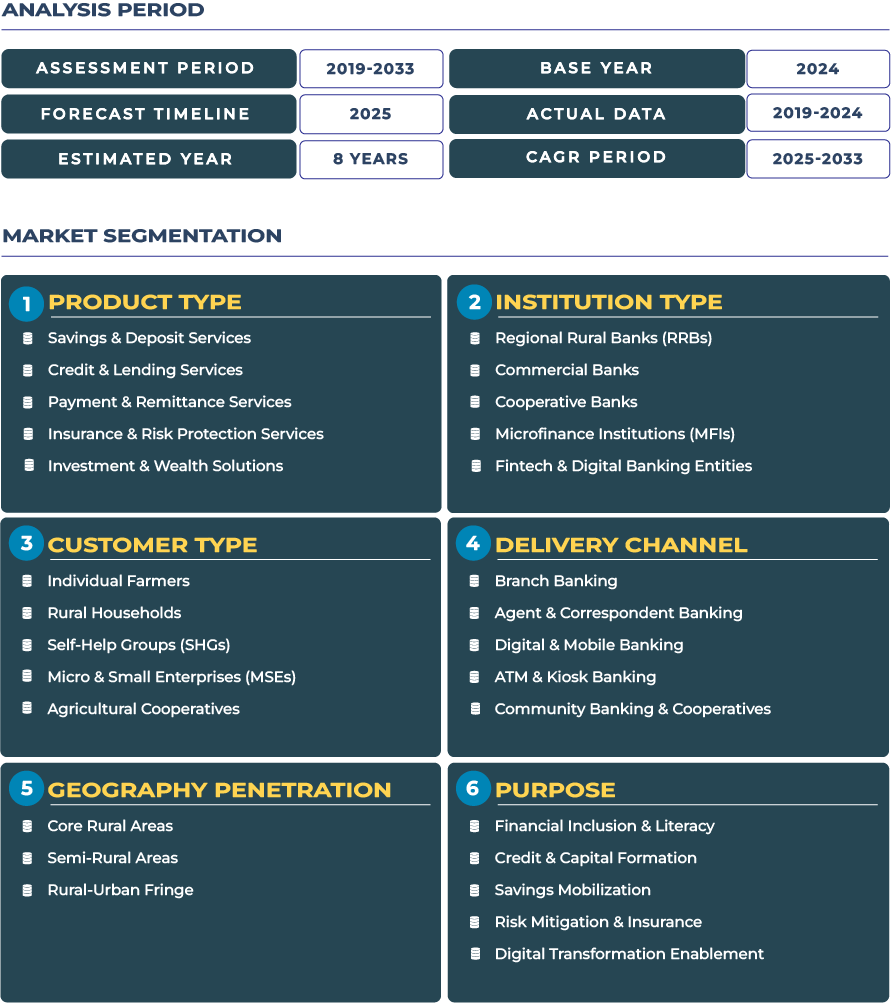Resilient Rural Lending through Policy and Technology in the US Rural Banking Market
The US rural banking market is undergoing a profound shift as federal policy frameworks converge with private fintech innovation to bolster small-holder resilience across America’s agrarian regions. Unlike the image of static branch networks and legacy credit models, the rural banking sector is now dynamic, anchored by agencies such as the USDA Rural Development and complemented by agile digital lenders. In the wake of pandemic-era disruptions, geopolitical volatility, supply-chain pressures and climate stress on farm income, lenders are re-engineering their offerings from basic deposit and loan services to integrated platforms that bundle credit, savings, risk protection and investment vehicles for rural clients. This melding of policy safety-nets, data-driven underwriting and rural finance ecosystems places US rural banking at the intersection of inclusion, productivity and resilience.
Note:* The market size refers to the total fees/revenue generated by banks through various services.
US Rural Banking Market Outlook: Forecasting the US Rural Banking Market Modest Growth, Focused Impact
In 2025, the US rural banking market is projected at approximately USD 31.4 billion, with expectations to reach about USD 35.2 billion by 2033, implying a modest compound annual growth rate of 1.5%. This constrained growth reflects the mature nature of the rural banking landscape, the demographic headwinds of shrinking farm populations, and margin pressures in small-market lenders. Nonetheless, the growth is meaningful in its strategic importance: incremental expansion is driven by enhanced financial inclusion, digital credit capabilities and renewed product lines such as micro-leasing of equipment, embedded insurance coverage in crop-finance, and remote deposit/transaction services for underserved regions. The rural banking ecosystem increasingly aligns with climate-smart agriculture, government loan guarantees and fintech partnerships that reduce operating cost and risk exposure. Though the overall market growth is modest, the value chain impact on agribusiness credit, farm productivity and rural community stability is substantial. Financial institutions and policy bodies alike must navigate interest-rate cycles, credit risk, climate exposure and digital infrastructure gaps, contextualising the 1.5% growth within a broader transformation of the rural finance model.
Drivers & Restraints: Infrastructure Modernisation, Credit Access and Structural Constraints in US Rural Banking
Driving growth: Key catalysts for the US rural banking sector include a surge in specialty crop contract farming, rise of ag-tech financing for precision agriculture and expansion of loan guarantee programmes under USDA Rural Development. For instance, rural banks are increasingly underwriting operating loans tied to off-farm income streams such as agritourism or value-added processing. The guarantee programmes lower lender risk, enabling smaller community banks to extend credit to thin-file borrowers. Additionally, payment and remittance services tailored for rural communities are gaining traction, digital platforms enable seasonal labourers and smallholders to access savings accounts, remit funds and build credit histories, thereby strengthening the deposit base and credit pipeline.
Constraining growth: On the flip side, structural impediments continue to hamper growth. Many rural banking branches are ageing, hampering delivery of modern digital services and increasing cost-to-serve. Community banks face heightened regulatory and compliance burdens, capital, liquidity and cybersecurity requirements have escalated, reducing margin space for credit innovation. Broadband connectivity remains patchy in remote farm regions, limiting digital delivery of banking and repayment monitoring. Furthermore, climate variability and supply-chain disruptions add to credit loss risk, lenders must allocate more capital to risk protection services, which compresses net interest income. The combination of shrinking rural populations, tight margins and rising compliance burdens explains why market growth remains below historical pace despite structural opportunity.
Trends & Opportunities: Platform-Based Innovation, Embedded Finance and Growth Avenues in the Rural Banking Landscape
Major trends: Platform-based ag-lending is gaining ground as banks embed loan originations within farming input suppliers or agribusiness platforms. Real-time satellite and IoT data allow lenders to assess crop yield risk, manage collateral remotely and streamline lending decisions. Embedded crop-insurance bundling is emerging: rural banks now offer parametric insurance tied to weather triggers, packaged alongside standard loan products, thereby reducing credit risk and differentiating offerings. Furthermore, mobile-first micro-loan products and fintech partnerships are expanding rural access, community banks use digital onboarding and alternative data to serve borrowers beyond branch reach.
Opportunity landscape: Significant opportunities lie in micro-leasing for on-farm sensors, solar-powered irrigation and digital mortgage products for rural housing rehabilitation. These financing tools unlock new revenue streams, investment/wealth solutions for rural households, for example, are evolving beyond savings accounts to include indexed savings products linked to agricultural commodities. Lenders are also exploring income-share agreements for farm kids returning to family operations, with digital tracking of productivity and payouts. Policy support via USDA energy and infrastructure grants enhances rural bank ability to offer bundled services for rural clients. Therefore, while headline growth may remain modest, the breadth of product innovation in the rural banking ecosystem presents meaningful upside for well-positioned institutions.
Competitive Landscape: Partnerships and Digital Strategy Define Tomorrow’s Rural Banking Leaders
The competitive environment in the US rural banking sector is evolving rapidly. Institutions are deploying strategies such as offering USDA-guaranteed hybrid loan products and deploying satellite-based credit-scoring pilots to expand outreach. In July 2025, CoBank launched a USD 1.5 million rural prosperity grant-programme across 23 states, reinforcing its role as a strategic player in rural development. In July 2025, First Mid Bank upgraded to a new core-banking platform powered by Jack Henry & Associates’ open ecosystem, enabling digital-first service delivery in rural markets. Such initiatives reflect a broader shift: rural banking institutions must partner with ag-tech platforms, mobile fintechs and data-analytics firms to reduce cost-to-serve, mitigate credit risk and enhance customer experience. The competitive moat is increasingly defined by digital infrastructure and platform reach, rather than branch count alone.







